Navigating Smart Agriculture: Innovations and Challenges


Intro
The agricultural landscape is undergoing a monumental transformation, driven by smart agriculture, where technology meets traditional farming. As the global population swells, the pressure on food production escalates. This is where smart agriculture steps in, promising enhancements to efficiency and sustainability. Despite its potential, the sector faces hurdles that could slow down its progress. In this article, we’ll explore the intricate interplay of challenges and innovations within smart agriculture.
Overview of the Topic
Definition and Importance
At its core, smart agriculture refers to leveraging advanced technologies to improve agricultural practices. This includes everything from drones that monitor crops to sensors in the soil that provide real-time data. The beauty of smart farming lies not only in its ability to boost yields but also in its potential to revolutionize how farmers approach sustainability. In simple terms, it’s about farming smarter, not harder.
Current Trends
Several trends are currently shaping the realm of smart agriculture. The rise of precision agriculture is a standout. Farmers can target specific areas of a field to apply water or fertilizer, ensuring that resources are used wisely. Moreover, the integration of Internet of Things (IoT) devices provides invaluable data that helps farmers make informed decisions. Also, data analytics is poised to become an essential tool for optimizing farming processes. Armed with these insights, farmers can better predict crop yields and reduce waste.
Key Techniques and Practices
Step-by-Step Guide
- Assess Your Needs: Understand which areas of your farming operation require improvement.
- Research Technologies: Look into various smart farming tools available on the market.
- Integrate Tools: Start with one or two technologies, such as soil sensors or drones, and integrate them gradually.
- Monitor and Adjust: Use data collected to inform your decisions continuously. This means analyzing what’s working and what isn’t.
Tools and Equipment Needed
- Drones: For monitoring crop health and field conditions.
- Soil Moisture Sensors: To measure water saturation levels.
- Farm Management Software: Helps track progress and make data-driven decisions.
Challenges and Solutions
Common Obstacles
While smart agriculture is promising, it’s not without its challenges. One significant obstacle is the initial cost of technology. Many farmers may find it tough to justify the investment, especially on tight budgets. Additionally, a lack of technical knowledge can hinder the adoption of these innovations. On top of that, connectivity issues in rural areas can restrict access to necessary data.
Innovative Solutions
To address these challenges, stakeholders are beginning to step up. There are initiatives offering grants and loans to help farmers embrace modern tools without breaking the bank. As for training, local agricultural organizations are starting workshops to enhance farmers’ tech skills. Collaborations among tech companies and farmers are sprouting, making solutions more accessible than ever.
"Collaboration is key to overcoming barriers in smart agriculture, and this partnership can lead to remarkable advancements in the field."
Understanding Smart Agriculture
In the contemporary landscape of farming, understanding smart agriculture is paramount. This revolutionary approach not only enhances productivity but also aligns with sustainability goals. Smart agriculture encompasses a wide array of practices leveraging technology to optimize yields and manage resources efficiently.
As agricultural challenges mount, from climate change to food security concerns, the adoption of innovative practices becomes more pressing. Smart agriculture provides a pathway to address these issues by integrating advanced technologies into traditional farming methods. Key elements of this practice include automation, data analytics, and connectivity, which together offer transformative benefits.
The significance of understanding smart agriculture extends to its capacity for improving decision-making and resource management. By utilizing data-driven insights, farmers can apply interventions more effectively, reducing waste and maximizing output. Hence, this article will delve into various facets of smart agriculture, examining its innovations and the hurdles it faces.
Defining Smart Agriculture
Smart agriculture can be defined as the integration of innovative technologies into farming practices with the aim of optimizing resource use and maximizing productivity. It encompasses a variety of tools and methods that ensure farmers can make informed decisions based on real-time data. It’s about taking farming from an instinctual practice to one grounded in hard facts and well-analyzed information.
Historical Context
Historically, agriculture has evolved through several phases. The shift from subsistence farming to more modern approaches has paved the way for what we now see as smart agriculture. Initially, agriculture relied on manual labor and traditional methods. With the advent of mechanization, farmers began using tractors and other machinery to improve efficiency. Then came advancements in technology, such as the introduction of fertilizers and pesticides, shaping modern agricultural practices.
The move towards precision agriculture in the late 20th century marked a significant turning point. As leaders recognized the potential of data and technology, tools like satellite imagery and GPS emerged. This evolution culminated in the era of smart agriculture we recognize today, where data analytics, the Internet of Things, and artificial intelligence play crucial roles in shaping a sustainable agricultural future.
Key Components
Automation
Automation in smart agriculture refers to the use of various technologies to perform tasks that would typically require human intervention. This ranges from simple equipment such as automated irrigation systems to complex machinery like self-driving tractors. The main characteristic of automation is efficiency; it greatly reduces labor costs and increases output.
The unique feature of automation in smart agriculture is its ability to operate continuously and precisely, allowing for consistent application of inputs such as water, fertilizers, and pesticides. While there are substantial benefits in terms of productivity, challenges remain, including high initial costs and the need for skilled technicians to operate and maintain such equipment.
Data Analytics
Data analytics involves collecting and analyzing data from various sources - including field sensors and satellite imagery - to inform decision-making in agriculture. The primary advantage of data analytics is its ability to provide actionable insights that can lead to improved productivity and resource management.
One unique aspect of data analytics is precision farming, where data-driven solutions allow farmers to apply inputs more accurately than ever before. However, managing vast amounts of data can be a double-edged sword, as farmers must also navigate issues related to data privacy and interpretation.
Connectivity
Connectivity in smart agriculture refers to how devices and systems communicate and share information. This component is critical for the seamless operation of other technologies in agriculture, such as IoT devices. Enabling real-time data transfer and remote monitoring, connectivity enhances overall efficiency in farming.
The key characteristic of connectivity is its role in unifying diverse agricultural technologies into a cohesive system. While it simplifies management, the dependency on internet services can be a drawback in rural areas where connectivity may be unreliable or non-existent.
In summary, understanding the components of smart agriculture enables farmers to leverage technology more effectively and ensures they are prepared to face the challenges that lie ahead.
Technological Innovations in Smart Agriculture
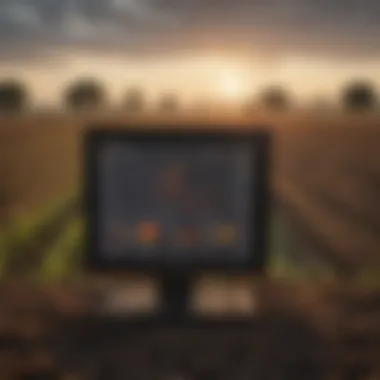
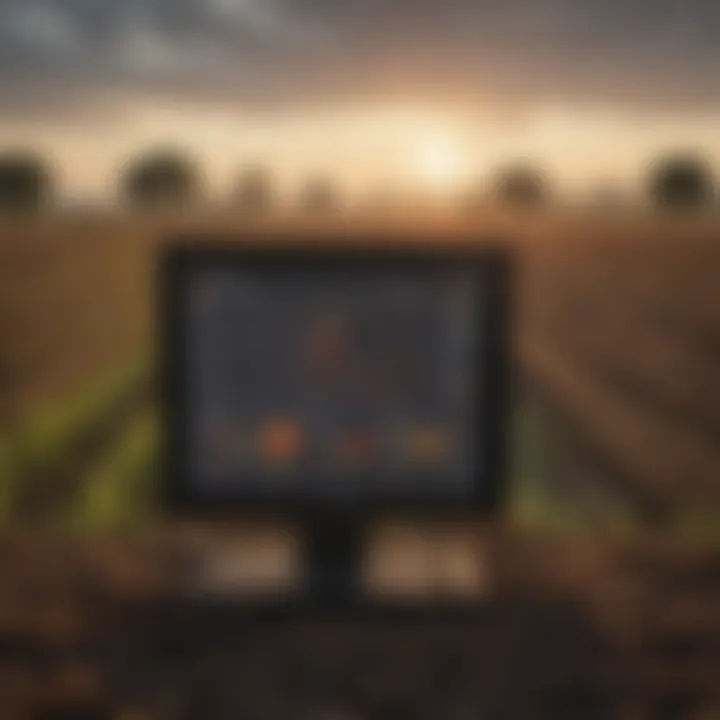
Technological innovations lie at the heart of smart agriculture, fundamentally transforming how food is produced. These advances pave the way for improved productivity, resource efficiency, and sustainability in farming practices, which are all crucial as we navigate the challenges of a growing global population and climate change. By harnessing the power of precision agriculture, IoT applications, and artificial intelligence, modern farms can optimize operations and tackle issues that have long plagued the industry. The benefits are manifold, but they come with their own set of considerations that stakeholders must address.
Precision Agriculture
Drone Technology
Drone technology has made significant inroads into agriculture, offering farmers the ability to survey their land with precision that was once unattainable. By utilizing high-resolution imaging, these flying devices can monitor crop health, assess soil conditions, and even assist in pest control. Drones are characterized by their capability to cover large tracts of land quickly and efficiently, making them a highly beneficial option for farmers looking to increase their productivity.
One unique feature of drones is their ability to generate detailed maps and models for precision farming, which allows for targeted interventions rather than blanket treatments. However, the cost of integrating drone technology can be a barrier for smallholder farmers, potentially widening the gap between large agricultural enterprises and smaller-scale operations.
GPS and GIS Systems
Global Positioning Systems (GPS) and Geographic Information Systems (GIS) have transformed how farmers plan and manage their fields. These systems provide critical information about land features, helping farmers utilize their plots more effectively. The key characteristic of GPS is its ability to pinpoint exact locations on Earth’s surface, enabling activities like soil sampling and crop mapping to be done with pinpoint accuracy. This makes them a pivotal tool in the realm of smart agriculture.
One unique aspect of GIS is its capacity to handle and visualize complex data sets related to topography, weather patterns, and more. Nonetheless, the technical skills required to operate these systems can be steep, sometimes creating barriers for those who aren’t tech-savvy.
Internet of Things (IoT) Applications
Sensor Networks
Sensor networks form the very backbone of IoT applications in agriculture, providing real-time data crucial for informed decision-making. These networks consist of numerous sensors that collect data on soil moisture, temperature, humidity, and other environmental variables. The essential characteristic of sensor networks is their ability to relay information continuously, offering farmers a detailed overview of their field conditions.
This continuous feed of information makes sensor networks a vital choice for precision farming as they allow for timely responses to changing conditions, ultimately enhancing yield potential. However, the challenge lies in managing and interpreting the vast amount of data these networks produce, as silos of information can lead to confusion rather than clarity.
Smart Irrigation Systems
Smart irrigation systems have revolutionized water management in agriculture. They automate watering based on real-time soil moisture data collected by sensors. This key characteristic makes them a promising solution in regions plagued by water scarcity. Farmers can now tailor their irrigation efforts more precisely, conserving water and reducing waste. One unique feature of smart irrigation is its capacity to integrate with weather forecasts, allowing for proactive water management ahead of rainstorms or dry spells. While the upfront costs of installation can be high, the long-term savings and resource management improvements often outweigh these initial investments.
Artificial Intelligence in Farming
Predictive Analytics
Predictive analytics employs statistical methods to forecast agricultural trends, offering farmers insights into potential market conditions, crop performance, and environmental impacts. This key characteristic allows for data-driven decision-making, positioning predictive analytics as a valuable tool in modern farming.
What sets predictive analytics apart is its ability to process historical data along with current indicators to forecast future conditions. However, while predictive analytics can enhance planning and reduce uncertainty, there's always a risk of relying too heavily on predictions that may not account for unexpected variables.
Machine Learning Algorithms
Machine learning algorithms are integral to processing complex datasets, learning patterns from the data, and making autonomous decisions based on those patterns. This capacity makes machine learning a powerful asset in areas such as crop yield prediction and resource allocation. The decisive characteristic of machine learning is its ability to improve over time, adapting to new data inputs. Nevertheless, implementing machine learning can be a double-edged sword; the complexity of algorithms may require specialized skills, making it hard for the average farmer to fully take advantage of these innovations without support.
In the landscape of agriculture, embracing technological innovations is not just an option—it's an imperative for sustainable growth and productivity.
Benefits of Smart Agriculture
The landscape of agriculture is changing rapidly, influenced by the vital trends of smart farming. Embracing this transformation offers numerous advantages that extend beyond mere yield increases. The benefits can be broadly categorized into enhanced productivity, sustainability impacts, and economic benefits. Each of these categories encapsulates specific elements that play a crucial role in shaping a more efficient and environmentally-friendly agricultural future.
Enhanced Productivity
The first promise of smart agriculture lies in enhanced productivity. This section delves into two key areas: yield improvement and resource optimization.
Yield Improvement
Yield improvement is at the core of smart agriculture. By employing innovative methods like precision farming and data analytics, farmers have managed to significantly boost crop production. One notable characteristic of yield improvement is the ability to tailor farming practices to meet the specific needs of different crops. For instance, using variable rate technology allows farmers to apply fertilizers in precise amounts based on soil nutrient levels.
This tailored approach not only maximizes yield but also minimizes waste. However, while the advantages are numerous—such as increased food security—it is vital to also acknowledge the initial investments required for technology. Overall, yield improvement represents a pivotal shift towards more productive and sustainable agricultural practices.
Resource Optimization
Resource optimization complements the enhancements seen in yield improvement. In essence, effective resource management can lead to reduced inputs like water, fertilizers, and pesticides while maintaining—or even increasing—crop yields. Here, the use of IoT sensors plays a significant role in monitoring field conditions in real-time.
A unique feature of resource optimization is its focus on efficiency. By applying only what’s needed, farmers can mitigate excess usage which can harm the environment. Such practices not only benefit the farmer’s bottom line but also contribute towards conserving vital resources that future generations will need. Yet, challenges persist with training and technology adaptation, making it essential for farmers to stay informed and proactive in embracing these innovations.
Sustainability Impacts
Sustainability is a cornerstone of smart agriculture, emphasizing practices that lead to responsible farming. This aspect encompasses reduced pesticide use and water conservation, both of which are crucial to long-term ecological health.
Reduced Pesticide Use
Reduced pesticide use is a significant benefit rooted in smart agriculture practices. By relying on integrated pest management systems and applying targeted pest control measures, farmers can drastically decrease their chemical footprint. This characteristic not only enhances soil health but also protects surrounding wildlife and biodiversity.
The unique aspect of reduced pesticide use is its direct correlation with increased consumer demand for organic products. As more individuals seek out sustainable food sources, farmers stand to gain from aligning their practices with market preferences. However, it’s critical to mention that thorough education on pest management is necessary, as improper application can lead to resistance and other unforeseen complications.
Water Conservation
Water conservation has emerged as a pressing issue in agriculture, particularly as climate change leads to unpredictable droughts and water shortages. Smart irrigation systems play a key role here, utilizing technology to deliver water precisely when and where it’s needed.
An effective characteristic of water conservation is its dual benefit—it not only saves water but also lowers costs associated with irrigation. With increasingly efficient practices, farmers can expect to see better crop health while contributing to broader environmental goals, such as preserving local water sources. However, these systems can entail high initial setup costs and require ongoing maintenance, demanding commitment from farmers.
Economic Advantages
The economic aspect of smart agriculture provides a compelling argument for its adoption, focusing on cost efficiency and market competitiveness.
Cost Efficiency
Cost efficiency entails using smart technologies to create savings that can enhance the overall farm operation. Some farmers have reported drastically reduced operating costs, thanks to precision agriculture and automation. A defining characteristic of cost efficiency is its ability to transform what may initially be a high investment into long-term savings.
The uniqueness of cost efficiency lies in its ability to lower fixed costs through increased productivity while spreading variable costs across greater output. Nonetheless, it’s crucial to balance investment with expectations as the transition can be gradual and must align with individual farm goals.
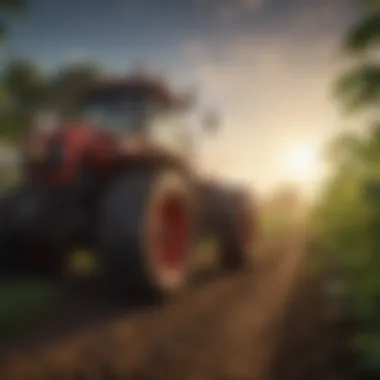
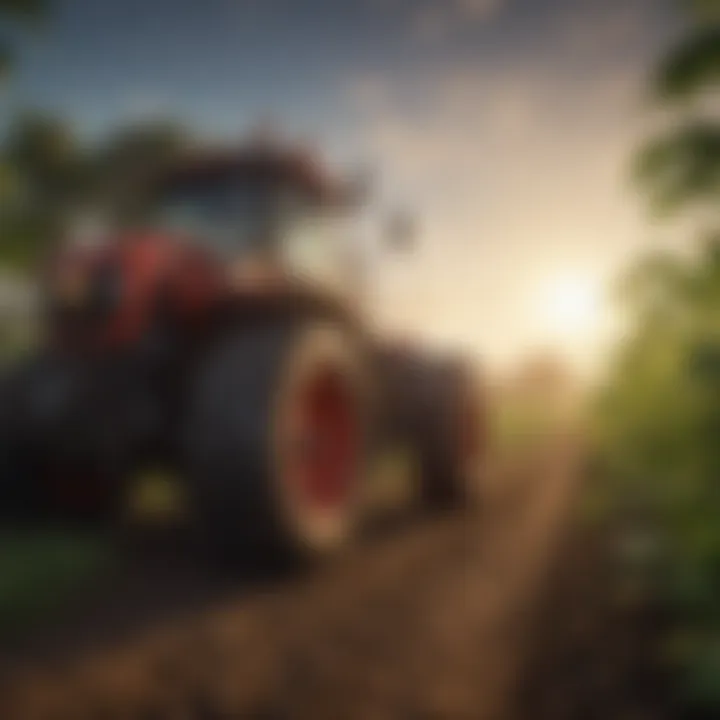
Market Competitiveness
Market competitiveness becomes more pronounced with smart agricultural practices. By adopting new technologies, farmers can position themselves favorably in an ever-evolving marketplace. A standout aspect of market competitiveness is the ability to access global markets previously unreachable—thanks to improved logistics and data analytics.
In this way, farmers can respond quickly to consumer trends and shifts. Yet, as they embrace these tools, they also face challenges such as maintaining quality while scaling up operations. Overall, enhancing market competitiveness means not just survival, but thriving in the agricultural sector.
The integration of technology in agriculture is not just about harvesting crops; it's about fostering a sustainable future for generations to come.
Challenges in Adoption of Smart Agriculture
Adopting smart agriculture practices is no walk in the park. The journey is fraught with hurdles that can discourage even the most dedicated farmers. Understanding these challenges is essential for moving towards a future where agriculture is not just efficient but also sustainable.
Farming is already a tough gig, so when you throw in the complexity of new technologies, it ups the ante. Every farmer must weigh the advantages of smart systems against the obstacles that come with them. Not just the cost, but also the technical barriers and how to manage a mountain of data effectively. Tackling these challenges is important for the overall goal of revolutionizing farming through smart technologies.
High Initial Costs
When it comes to the adoption of smart agriculture techniques, the sticker shock can be pretty overwhelming. The initial investment in cutting-edge technology like drones, IoT devices and sophisticated training systems can cause some farmers to hesitate.
Imagine spending a small fortune on equipment that might take years to pay off. The reality is many farmers operate on thin margins and might not have the cash flow to splash out on such technologies. This financial burden can discourage potential adopters, making it tough for them to see the long-term benefits of these innovations.
Technical Barriers
Skills Gap in Workforce
A major stumbling block in the journey toward smart agriculture is the skills gap in the workforce. This gap refers to the mismatch between the skills farmers and their workers possess and those needed to operate smart agricultural technologies effectively.
This lack of training can lead to poor implementation of systems that promise to make farming more efficient. The workforce may need hands-on training or certifications to handle advanced machinery or data analysis software. Ignoring this gap can erode trust in new technologies, leading to an overall resistance to change.
Integration Issues
Integration often serves as a barrier in the smooth adoption of smart agricultural practices. Farms today might have various forms of technology already in use, from traditional machinery to basic automation tools. Adding new technologies can sometimes mean going back to the drawing board to ensure that everything plays nicely together.
The challenge lies in aligning these different systems so they can communicate effectively. Technical shortcomings might result in frustrations or misconceptions about the benefits of smart agriculture. Getting the integration just right can be a fine balancing act, and messing it up may lead to wasted investments.
Data Management Concerns
As farmers leap into smart agriculture, they soon find themselves drowning in data. While having access to large amounts of information can be beneficial, managing this data can feel like trying to drink from a fire hose.
Data Privacy
With an increase in data comes the inevitable concern about privacy. Farmers often handle sensitive information, from crop yields to financial records, and keeping this data secure is paramount. Data breaches in the agricultural space can lead to significant losses, both financially and in terms of reputation.
The challenge is to adhere to regulations and ensure customers that their data will be well-protected. This aspect significantly affects farmers’ willingness to adopt smart technologies that rely heavily on data collection and analysis.
Information Overload
Information overload is another concern swirling around like a relentless storm cloud. Today’s technologies provide a plethora of data meant to enhance farming decisions. But when farmers receive more information than they can reasonably process, it can lead to confusion rather than clarity.
The ability to sort through this mountain of data and extract actionable insights is critical. Overloading farmers with information can hinder decision-making processes, making it difficult for them to leverage the very innovations designed to help them.
In addressing these challenges, collaboration and skill development can serve as lifelines that save farmers from potential pitfalls. Tackling these problems head-on can lead to innovative solutions and strengthen the agricultural industry for generations to come.
Collaboration and Stakeholder Engagement
The tapestry of smart agriculture is woven together by the threads of collaboration and stakeholder engagement. In the realm of modern farming, it becomes crucial to foster avenues for cooperation among various players—be it farmers, tech providers, governmental bodies, or community organizations. This synergy not only enhances the efficacy of smart agricultural practices but also lays a strong foundation for innovation and sustainable development. The importance of involving diverse stakeholders cannot be overstated, as their unique perspectives and expertise contribute to creating a well-rounded, effective approach to tackling agricultural challenges.
In this landscape, stakeholders bring in their varied insights that shape user-centered technologies, promote inclusivity, and ensure that advancements resonate with local needs. Ultimately, collaboration acts as a catalyst, breaking down silos and leading to a more integrated, adaptive agricultural ecosystem.
Role of Government Policies
Government policies play a pivotal role in supporting and guiding the adoption of smart agriculture. They provide a structured approach for stakeholders, framing the landscape that enables or hinders innovation.
Subsidies and Grants
Subsidies and grants serve as critical tools that incentivize farmers and technology providers to invest in smart agriculture solutions. By offering financial support, governments can reduce initial costs that often deter many from making the leap toward modernized practices.
- Key Characteristic: The main appeal of subsidies and grants lies in their ability to lower the financial barrier for entry.
- Why Beneficial: These initiatives are considered beneficial as they not only stimulate investment but also spur local economies by creating jobs in the technology and agricultural sectors.
However, there's a unique feature to consider: the dependency on these financial aids can become problematic over time. Continuous reliance might inhibit the development of self-sustaining business models, leaving some farmers vulnerable once funds dissipate.
Regulatory Frameworks
Regulatory frameworks shape the operating environment for smart agriculture, determining how technologies can be integrated into farming practices legally and ethically.
- Key Characteristic: They provide guidelines that help ensure safety, data privacy, and sustainability within the industry.
- Why Beneficial: Positive frameworks encourage innovation by streamlining processes and assuring stakeholders that they are functioning within accepted legal limits.
On the flip side, regulatory frameworks can also impose constraints that may slow down progress. Bureaucratic hurdles can stymie agility—the very essence of innovation—when farmers or tech developers must navigate complex legal environments to implement new solutions.
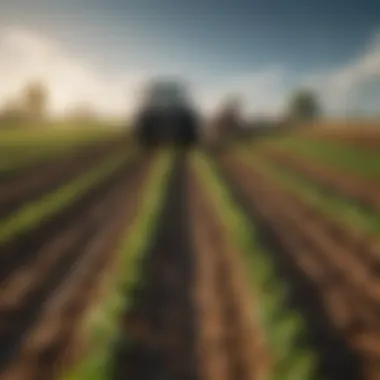

Partnerships between Farmers and Technology Providers
The collaboration between farmers and technology providers stands as a cornerstone of smart agriculture. This partnership enables the translation of cutting-edge technologies into practical applications tailored to meet the specific needs of farmers. Successful partnerships often involve not just purchasing technology but engaging in dialogue about the best ways for these tools to be - sucsefully - applied. It’s not just about selling gadgets; it’s about building solutions that resonate with the everyday challenges farmers face. Different types of tech providers, from software engineers to equipment manufacturers, can offer a wealth of knowledge that enhances a farmer’s operation, making processes more efficient and productive.
Community Engagement in Smart Agriculture
Community engagement becomes vital for embedding smart agriculture practices at the Grassroots level. It empowers local farmers, fostering a sense of ownership over technological innovations and enabling them to actively participate in their implementation.
Training Programs
Training programs specifically target skill development, crucial for farmers seeking to harness new technologies.
- Key Characteristic: These programs often blend hands-on experience with theoretical knowledge, ensuring practical learning.
- Why Beneficial: By providing farmers with the requisite skills to use modern technologies, these programs empower them to efficiently integrate smart solutions into their operations.
The unique feature of training programs lies in their adaptability. They can be tailored to face local conditions, providing relevant learning experiences that resonate most with participants. However, the challenge remains in consistently reaching and engaging the target audience, especially in diverse rural areas.
Knowledge Sharing Initiatives
Knowledge sharing initiatives also play an integral role in disseminating best practices and success stories in smart agriculture.
- Key Characteristic: They promote community learning, enabling farmers to learn from each other’s experiences.
- Why Beneficial: Sharing knowledge fosters a collaborative spirit within agricultural communities, helping individuals to adopt new practices more rapidly and effectively.
The unique feature of these initiatives is their potential for scalability; what works in one community can often be shared and adapted elsewhere. On the downside, the effectiveness can sometimes be hindered by varying levels of engagement or resistance to change amongst farmers.
Ultimately, collaboration and stakeholder engagement are not just buzzwords; they are essential components in driving the future of smart agriculture forward, making it more resilient and adaptable to the challenges at hand.
Future Trends in Smart Agriculture
As we navigate the exciting landscape of smart agriculture, understanding future trends is crucial for farmers and stakeholders in the agricultural field. The integration of cutting-edge technologies will not only shape farming practices but also address many of the pressing challenges that agriculture faces today.
These innovations hold the promise of enhancing efficiency and sustainability, ensuring that food production keeps pace with an ever-growing global population.
Emerging Technologies
Robotic Farming
Robotic farming is evolving rapidly, transforming the way farming is conducted. This technology involves the use of advanced machines to perform tasks traditionally done by human laborers. These robots can plant seeds, harvest crops, and even monitor fields.
One of the key characteristic of robotic farming units is their precision. They can work tirelessly, executing tasks with a level of accuracy that often surpasses humans, which leads to reduced crop damage and higher yields. These machines also operate in types of terrains where human intervention would be difficult or unsafe, such as steep hillsides or wet fields.
The cost can be a hurdle for some, bringing an initial investment that isn't always feasible for smaller farm operations. Yet, the long-term savings in labor costs and the ability to operate 24/7 can balance this out.
Blockchain in Agriculture
Blockchain technology presents a unique opportunity for the agricultural sector by enabling secure, transparent, and traceable transactions. It offers a decentralized ledger that can track every step in the supply chain, giving consumers and farmers alike confidence in the authenticity of products.
The main benefit of blockchain is its ability to ensure transparency. For example, by scanning a QR code on produce, a customer can see the entire journey—from farm to table. This can improve food safety and instill trust in consumers.
However, the complexity of blockchain implementation can be daunting for some. Understanding the technology and needing top-notch internet connectivity can pose significant challenges.
Global Perspectives and Innovations
International Case Studies
International case studies serve as a powerful testament to the efficacy and adaptability of smart agriculture practices. By examining these examples, stakeholders can gauge what technologies and methods work well in different climates and cultures.
Countries such as the Netherlands are leading examples where advanced greenhouse technology maximizes yields in limited spaces, showcasing the boundless possibilities of innovative strategies tailored to specific needs.
These case studies are essential; they provide valuable insights and practical lessons that can be adapted locally. However, one must temper expectations since what works in one region may not translate perfectly to another due to environmental differences.
Cultural Adaptations
Cultural adaptations in smart agriculture recognize the necessity of aligning technological advancements with local farming customs and practices. Integrating advanced methods with traditional knowledge promotes greater acceptance and efficacy.
For instance, a region that has relied on hand-pollination may need to slowly transition to drone-pollination methods, marrying old and new practices. This approach fosters a sense of ownership in the farming community and minimizes resistance to change.
However, there’s a risk: if the cultural adaptations aren’t carefully managed, farmers might not fully embrace the innovation, leading to unsuccessful outcomes.
The Role of Education and Research
Research Institutions
Research institutions play a pivotal role in propelling smart agriculture forward. They generate innovative solutions, conduct essential studies, and provide the groundwork for advancements in agricultural technology.
The key characteristic of these institutions is their commitment to ongoing exploration. By collaborating with farmers and tech developers, they ensure that research remains grounded in practical realities and addresses the challenges faced in the field.
Nevertheless, there can be a disconnect; sometimes, research outcomes do not translate seamlessly into practice. Ensuring that findings reach the intended users quickly is vital for the industry.
Curriculum Development
Curriculum development is equally as important in shaping the future of agriculture. By integrating smart agriculture principles into educational programs, schools can prepare future farmers and agronomists with the knowledge they need to thrive.
An effective curriculum should not only cover the theoretical basics but also offer hands-on experiences with new technologies. This prepares students for real-world applications while fostering innovation.
On the downside, shifting curricula takes time and resources, and there could be inertia in educational institutions slow to adapt to change. Striking a balance is crucial for fostering a new generation of agricultural leaders.



